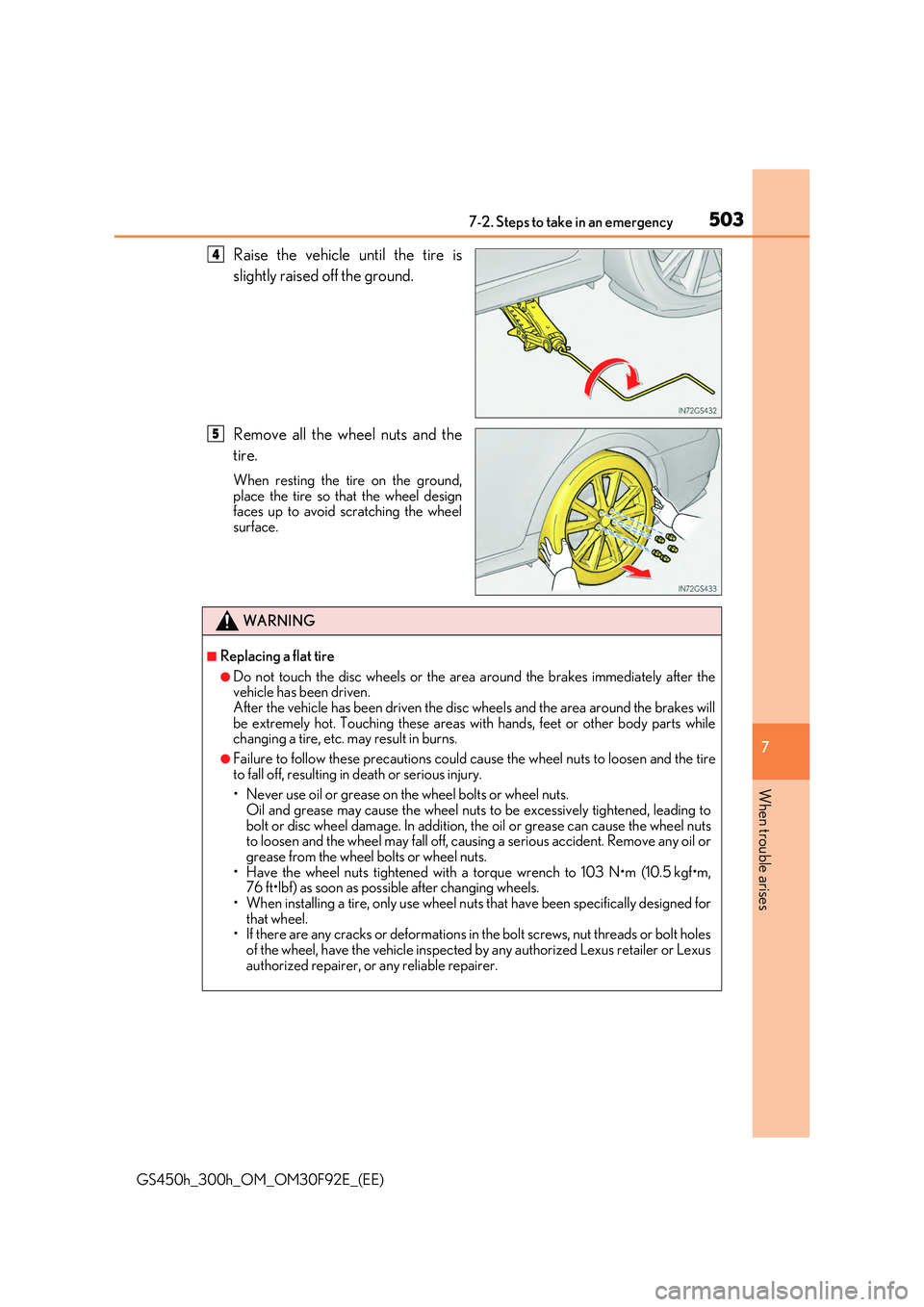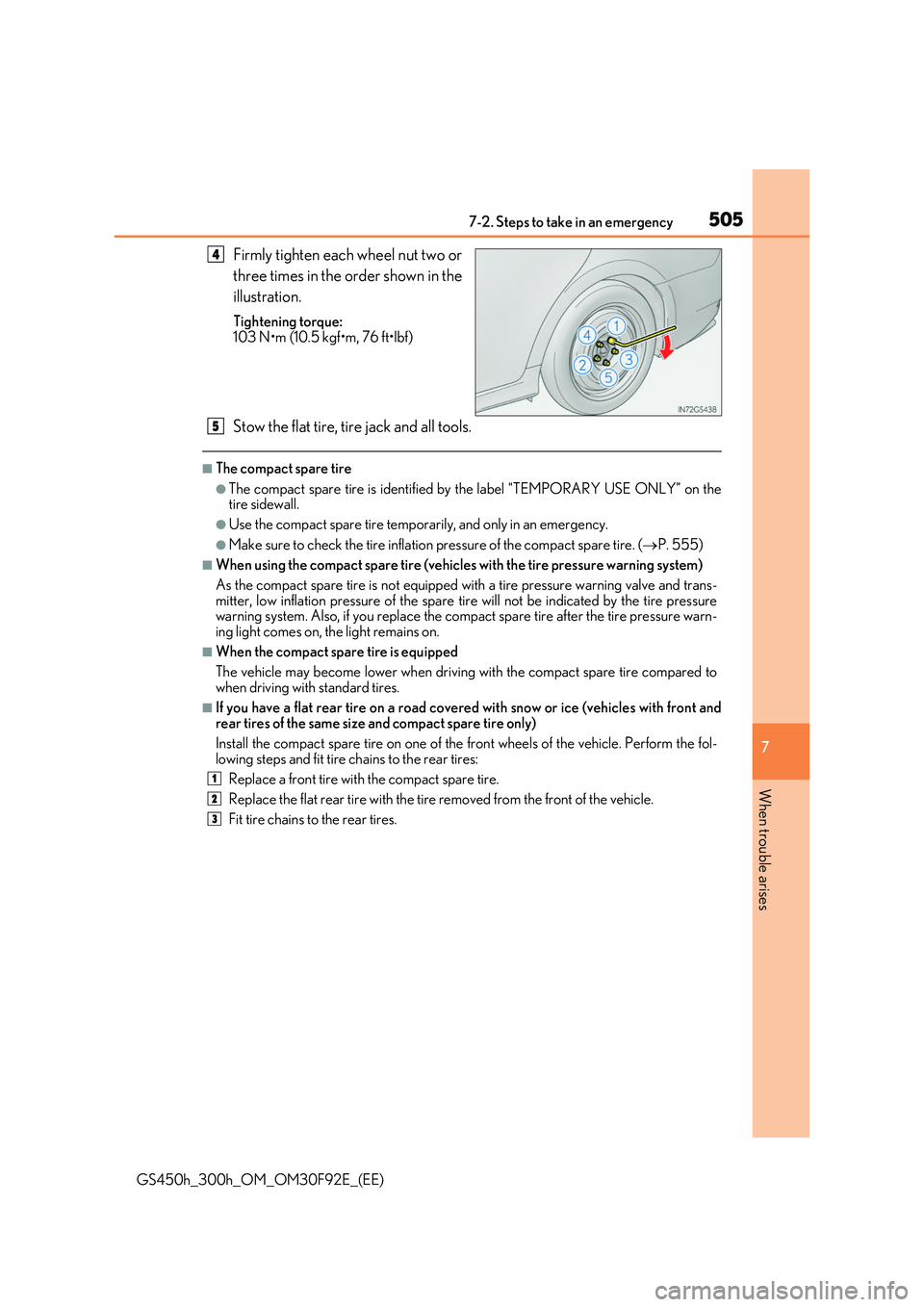Page 331 of 600

331
4
4-6. Driving tips
Driving
GS450h_300h_OM_OM30F92E_(EE)
Hybrid vehicle driving tips
◆Using Eco drive mode
When using Eco drive mode, the torque corresponding to the accelerator
pedal depression amount can be generate d more smoothly than it is in normal
conditions. In addition, the operation of the air conditioning system (heating/
cooling) will be minimized, improving the fuel economy. ( P. 311)
◆Use of Hybrid System Indicator
The Eco-friendly driving is possible by keeping the indicate of Hybrid System
Indicator within Eco area. ( P. 108, 123)
◆Shift lever operation
Shift the shift lever to D when stopped at a traffic light, or driving in heavy traf-
fic etc. Shift the shift lever to P when parking. When using the N, there is no
positive effect on fuel consumption. In the N, the gasoline engine operates but
electricity cannot be generated. Also, when using the air conditioning system,
etc., the hybrid battery (traction battery) power is consumed.
◆Accelerator pedal/brake pedal operation
●Drive your vehicle smoothly. Avoid abrupt acceleration and deceleration.
Gradual acceleration and deceleration will make more effective use of the
electric motor (traction motor) without having to use gasoline engine
power.
●Avoid repeated acceleration. Repeated acceleration consumes hybrid bat-
tery (traction battery) power, resulting in poor fuel consumption. Battery
power can be restored by driving with the accelerator pedal slightly
released.
◆When braking
Make sure to operate the brakes gently and in a timely manner. A greater
amount of electrical energy can be regenerated when slowing down.
For economical and ecological driving, pay attention to the following points:
Page 503 of 600

5037-2. Steps to take in an emergency
7
When trouble arises
GS450h_300h_OM_OM30F92E_(EE)
Raise the vehicle until the tire is
slightly raised off the ground.
Remove all the wheel nuts and the
tire.
When resting the tire on the ground,
place the tire so that the wheel design faces up to avoid scratching the wheelsurface.
4
5
WARNING
■Replacing a flat tire
●Do not touch the disc wheels or the area around the brakes immediately after thevehicle has been driven.After the vehicle has been driven the disc wheels and the area around the brakes will
be extremely hot. Touching these areas with hands, feet or other body parts while changing a tire, etc. may result in burns.
●Failure to follow these precautions could cause the wheel nuts to loosen and the tire
to fall off, resulting in death or serious injury.
• Never use oil or grease on the wheel bolts or wheel nuts. Oil and grease may cause the wheel nuts to be excessively tightened, leading to
bolt or disc wheel damage. In addition, the oil or grease can cause the wheel nuts to loosen and the wheel may fall off, causing a serious accident. Remove any oil orgrease from the wheel bolts or wheel nuts.
• Have the wheel nuts tightened with a torque wrench to 103 N•m (10.5 kgf•m, 76 ft•lbf) as soon as possible after changing wheels.• When installing a tire, only use wheel nuts that have been specifically designed for
that wheel. • If there are any cracks or deformations in the bolt screws, nut threads or bolt holesof the wheel, have the vehicle inspected by any authorized Lexus retailer or Lexus
authorized repairer, or any reliable repairer.
Page 505 of 600

5057-2. Steps to take in an emergency
7
When trouble arises
GS450h_300h_OM_OM30F92E_(EE)
Firmly tighten each wheel nut two or
three times in the order shown in the
illustration.
Tightening torque:
103 N•m (10.5 kgf•m, 76 ft•lbf)
Stow the flat tire, tire jack and all tools.
■The compact spare tire
●The compact spare tire is identified by the label “TEMPORARY USE ONLY” on the tire sidewall.
●Use the compact spare tire temporarily, and only in an emergency.
●Make sure to check the tire inflation pressure of the compact spare tire. (P. 555)
■When using the compact spare tire (vehicles with the tire pressure warning system)
As the compact spare tire is not equipped with a tire pressure warning valve and trans-
mitter, low inflation pressure of the spare tire will not be indicated by the tire pressure warning system. Also, if you replace the compact spare tire after the tire pressure warn-ing light comes on, the light remains on.
■When the compact spare tire is equipped
The vehicle may become lower when driving with the compact spare tire compared to when driving with standard tires.
■If you have a flat rear tire on a road covered with snow or ice (vehicles with front andrear tires of the same size and compact spare tire only)
Install the compact spare tire on one of the front wheels of the vehicle. Perform the fol-
lowing steps and fit tire chains to the rear tires:
Replace a front tire with the compact spare tire.
Replace the flat rear tire with the tire removed from the front of the vehicle.
Fit tire chains to the rear tires.
4
5
1
2
3
Page 549 of 600
549
8
8-1. Specifications
Vehicle specifications
GS450h_300h_OM_OM30F92E_(EE)
Fuel
Fuel type
EU area:
Unleaded gasoline conforming to European standard EN228 only
Except EU area: Unleaded gasoline only
Research Octane Number95 or higher
Fuel tank capacity (Reference)66 L (17.4 gal., 14.5 Imp.gal.)
Electric motor (traction motor)
TypePermanent magnet synchronous motor
Maximum outputGS450h147 kW
GS300h105 kW
Maximum torqueGS450h275 N•m (28.0 kgf•m, 202.8 ft•lbf)
GS300h300 N•m (30.6 kgf•m, 221.3 ft•lbf)
Hybrid battery (traction battery)
TypeNickel-Metal hydride battery
Voltage7.2 V/module
Capacity6.5 Ah (3HR)
QuantityGS450h40 modules
GS300h32 modules
Overall voltageGS450h288 V
GS300h230.4 V
Page 555 of 600
555
8
8-1. Specifications
Vehicle specifications
GS450h_300h_OM_OM30F92E_(EE)
Type A
*: For optimizing fuel economy, ECO tire pressure is recommended. Tire pressure
affects traveling comfort, road noise and steering characteristics.
Tires and wheels
Tire size225/50R17 94W
Tire inflation
pressure (Recommended cold tire inflation
pressure)
Vehicle speed
Front tire
kPa (kgf/cm2 or bar, psi)
Rear tire
kPa (kgf/cm2 or bar, psi)
More than 190 km/h(118 mph)300 (3.0, 44)300 (3.0, 44)
Normal pressure:
190 km/h (118 mph) or less240 (2.4, 35)240 (2.4, 35)
ECO pressure*:190 km/h (118 mph)
or less270 (2.7, 39)270 (2.7, 39)
Wheel size17 7 1/2J
Wheel nut torque103 N•m (10.5 kgf•m, 76 ft•lbf)
Page 556 of 600
5568-1. Specifications
GS450h_300h_OM_OM30F92E_(EE)
Type B
Type C
Tire size235/45R18 94Y
Tire inflation
pressure (Recommended cold tire inflation
pressure)
Vehicle speed
Front tire
kPa (kgf/cm2 or bar, psi)
Rear tire
kPa (kgf/cm2 or bar, psi)
More than 220 km/h (137 mph)300 (3.0, 44)300 (3.0, 44)
220 km/h (137 mph)
or less240 (2.4, 35)240 (2.4, 35)
Wheel size18 8J
Wheel nut torque103 N•m (10.5 kgf•m, 76 ft•lbf)
Tire size235/40R19 96Y XL
Tire inflation pressure
(Recommended cold tire inflation pressure)
Vehicle speedFront tire kPa (kgf/cm2 or
bar, psi)
Rear tire kPa (kgf/cm2 or
bar, psi)
More than 220 km/h (137 mph)300 (3.0, 44)300 (3.0, 44)
220 km/h (137 mph)
or less240 (2.4, 35)250 (2.5, 36)
Wheel size19 8J
Wheel nut torque103 N•m (10.5 kgf•m, 76 ft•lbf)
Page 557 of 600
557
8
8-1. Specifications
Vehicle specifications
GS450h_300h_OM_OM30F92E_(EE)
Type D
Compact spare tire (if equipped)
■When towing a trailer
Add 20.0 kPa (0.2 kgf/cm2 or bar, 3 psi) to the recommend ed tire inflation pressure and drive at speeds below 100 km/h (62 mph).
Tire size235/40R19 96Y XL (front) and 265/35R19 94Y (rear)
Tire inflation
pressure (Recommended cold tire inflation
pressure)
Vehicle speed
Front tire
kPa (kgf/cm2 or bar, psi)
Rear tire
kPa (kgf/cm2 or bar, psi)
More than 220 km/h (137 mph)300 (3.0, 44)300 (3.0, 44)
220 km/h (137 mph)
or less240 (2.4, 35)250 (2.5, 36)
Wheel size19 8J (235/40R19), 19 9J (265/35R19)
Wheel nut torque103 N•m (10.5 kgf•m, 76 ft•lbf)
Tire sizeT155/70D17 110M, T145/70D18 107M
Tire inflation pressure (Recommended cold tire
inflation pressure)
420 kPa (4.2 kgf/cm2 or bar, 60 psi)
Wheel size17 4T (T155/70D17), 18 4T (T145/70D18)
Wheel nut torque103 N•m (10.5 kgf•m, 76 ft•lbf)